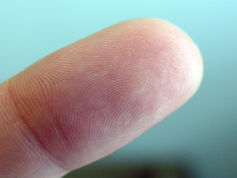Nerves of Endearment: How a Gentle Touch Affects Emotions (Op-Ed)


This article was originally published at The Conversation. The publication contributed the article to Live Science's Expert Voices: Op-Ed & Insights.
A soft and tender caress between two people can trigger a flood of emotions, and now we may have some idea why.
Research published in Neuron today suggests that certain sensory nerve cells, known as C tactile (CT) afferents, are involved in stimulating the emotions caused by gentle physical contact.
Francis McGlone, from Liverpool John Moores University in the UK, and colleagues argue that these cells, which are found in the skin of most mammals including humans, are critical for mediating social behaviours and even in giving beings a sense of “self”.
The senses of touch
There is a general tendency to lump all our somatic senses into a single classification: the “sense of touch”. This is inaccurate, since what we call touch actually comprises several distinct sensory systems.
Mammals sense pain and temperature changes via a primordial system of nerve cells that run within the spinal cord and brain. This system can signal the temperature in the environment or the presence of harmful stimuli, and typically trigger behaviours in the search of a suitable and safe environment.
Discriminative touch, a neural process operating in pathways well separated from these primordial systems, allows us and other mammals to localise tactile stimuli on our skin.
Get the world’s most fascinating discoveries delivered straight to your inbox.
These sensors are incredibly sensitive: they can recognise tiny details of external materials, identify the shapes of objects and allow blind people to read Braille.
Responding to a gentle touch
CT afferents are, in the neuroscience jargon, a distinct type of “unmyelinated, low-threshold mechanoreceptive unit” existing in the hairy skin of humans and other mammals.
These nerve cells belong anatomically and evolutionarily to the more primordial sensory system of the skin, together with pain and temperature sensors. Although known in humans for several decades, CT afferents continue to reveal new secrets.
The cells are stimulated by gentle pressure on the skin and what’s intriguing is they respond preferentially to stroking at a velocity similar to that of caressing.
CT afferents are also connected with those areas of the brain ‒ the insular cortex, the posterior superior temporal sulcus, the medial prefrontal cortex and the dorsoanterior cingulate cortex ‒ known to be activated by caressing and associated with feeling pleasure.
The behaviour of these sensory nerve cells suggests that the pleasure of having one’s skin stroked represents an innate, non-learned process, giving rise to the pleasures associated with social interactions.
This may explain the prevalence of social grooming (allogrooming) in many primate species.
A feeling of self
Those same areas of the brain that respond to caressing also receive sensory input from internal parts of the body (interoception). Here, internal and external signals combine to give a unique sense of body ownership, and by implication to create our embodied psychological “self”.
Over the past century, neuroscience has strived to bridge the gap between the two Cartesian worlds ‒ that is, to link the physical actions of sensory nerve cells with the subjective sensations and feelings that they produce.
Touch is one of the ways in which human and other animals establish a boundary between themselves and the external world, and these CT afferents through their stimulation may give rise to embodiment, the sense of being localised within one’s own body.
Far-reaching implications
Because CT afferents help mediate the interaction between the physical world and the internal world of the brain, hopes are high for their explanatory power.
They might even aid our understanding of such phenomena as pain perception, body image distortions, out-of-body experiences, neurodevelopmental disorders and placebo effects.
All these fascinating possibilities aside, there’s no doubt that a soft caress between two people remains among the most powerful of all emotional social signals. Our growing understanding of CT afferents is helping us explain how such deep feelings and emotions can be mediated by so gentle a touch.
Marcello Costa is the co-founder of Friends of Science and Medicine. As a member of the Australian Academy of Science he is committed to uphold the highest standard of science in Australian tertiary education and has no other vested interests.
This article was originally published on The Conversation. Read the original article. Follow all of the Expert Voices issues and debates — and become part of the discussion — on Facebook, Twitter and Google +. The views expressed are those of the author and do not necessarily reflect the views of the publisher. This version of the article was originally published on Live Science.




